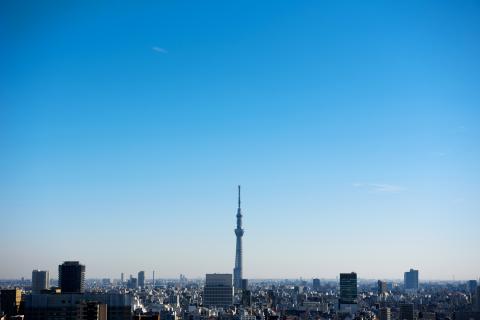A Tokyo bank once opened an account in the name of a man who had been dead for 1,000 years.
The bank was a branch of Tokyo-Mitsubishi UFJ (now part of MUFG, the largest bank in Japan), which looked out over a neighboring lot that contained the grave where the man was buried. The bank employees were reportedly instructed not to open any windows to the man’s grave, nor to turn their backs on it, even when at their desks; the account was set up to placate him.
The figure, Taira no Masakado, a rebellious warrior who was killed in 940AD but whose spirit has terrorized the region ever since. How Masakado became such a malevolent symbol to ordinary Tokyoites is the story of the city itself, and its centuries of violence, superstition and coincidence.

Photo: AFP
At the time of Masakado’s death, the region now known as Tokyo was little more than mudflats and plains of high reeds. Japan was ruled from far-away Kyoto — literally “the Capital” — while the Tokyo area was the lawless north, the destination for younger sons, bastards and outcasts who were packed off to the frontier. These borderland warlords called themselves the samurai — “those who serve” — and boasted of their lifelong loyalty to the throne.
POWER SHIFT
Mostly. Masakado was the first glimmering of a shift in power away from Kyoto and towards these new warriors. One day, announcing that the Sun Goddess had chosen him, he proclaimed himself emperor, killed a local governor and seized two northern provinces. Shocked by his treachery, the real emperor put a price on his head, which one of Masakado’s cousins soon collected. Dead or alive, however, the damage had been done: Masakado had challenged the sovereign’s divine authority.

Photo: Bloomberg
It wasn’t long before the legends began. He was said to be invulnerable, except for the top of his head, where his mother — a serpent — had failed to lick him. Plagues of butterflies supposedly warned of his revolt as rainbows broke out simultaneously in the capital.
The authorities tried to mock him by claiming that he was speared by sword-leaf trees in the afterlife, his liver eternally roasting — but this propaganda only revealed the degree to which he’d rattled them.
His daughter, Takiyasha, was said to live on in the ruins of his fortress, dabbling in necromancy and raising an army of frogs. In Japanese, frog (kaeru) is a pun on “return,” a hint that Masakado would come back to seek his revenge.
To prevent that, the authorities cut off his head and brought it to Kyoto, where they hung it from a tree in the marketplace. But the severed head howled in the night, and demanded to know where its body was.
Eventually, the head flew away. A temple in Gifu marks the spot where a local warrior shot at it with an arrow, and then it was on the move again, eventually coming to rest in an obscure fishing village called Shibazaki. The locals washed it, buried it with full honors and inscribed the gravestone with charms that prevented his escape. But lighting strikes and strange apparitions continued — and whenever bad luck struck the village, it was inevitably blamed on him.
Meanwhile, Masakado’s infamy was starting to grow among the rebellious samurai bad boys, who had taken to quoting his scandalous maxim: “The people of this world will always anoint their sovereigns through victory in combat.”
EDO, CITY OF THE SHOGUN
Eventually those rebels seized power for themselves through victory in combat, and Masakado was anointed the “first samurai.” His grave, located at the Buddhist Kanda Shrine, was now officially incorporated within the new capital city: the great Edo, now the city of the Shogun.
The position of Shogun was never meant to be permanent. It was supposed to be a crisis appointment: a hatchet-man for the emperor during a national emergency. The canny Tokugawa family, however, twisted it into a dynasty, and from the 1600s they became the de facto rulers of Japan for the next 250 years. By 1720 Edo had become the largest city in the world and the true power center of Japan — with Masakado as its shadowy patron.
Japan also deliberately cut itself off from other countries, while Edo became home to the “floating world,” an isolated enclave of artistic pursuits, advanced craft techniques and sometimes seedy nightlife. The popular kabuki theaters were censored from discussing politics, so instead the big-city audiences flocked to lurid tales of ancient vengeful spirits. Masakado (1836) was one of the hits, with his sorceress-daughter retelling his story and fighting off her pursuers with witchcraft.
But eventually Masakado’s people were themselves defeated. The samurai started to fade in relevance, and in 1868 a revolution overthrew the Shogun and “restored” the emperor. Edo was renamed To-kyoto (“Eastern Capital”), soon shortened to just Tokyo. Masakado’s grave wound up on the grounds of the new finance ministry.
Wary of his influence, in 1874 the new government officially proclaimed him an “enemy of the emperor,” ending his semi-divine status. Then the finance ministry burned to the ground in the 1923 earthquake.
Masakado was blamed. Rumors then spread that the replacement building, too, was cursed: accidents, falls and mishaps claimed 14 lives in five years — including that of the finance minister himself.
Gingerly, officials confessed that they had bulldozed the grave during construction. After the death of the finance minister, they hastily restored the grave in 1928, and a priest was called in to hold a “pacification ceremony” — because it’s rude to say “exorcism.” They forgot, however, to put back the stone slab carved with spells to hold Masakado in check.
That, at least, was the excuse offered in 1940 when nine nearby offices were destroyed in a lightning strike. The stone was put back, only to enter the news again in 1945 when it got the blame for causing a bulldozer to overturn, killing the driver. The US Army Occupation force had planned to turn the area into a car park, but were persuaded after the accident that the best policy was to leave Masakado in peace.
The Mitsui Finance Corporation didn’t get the memo. Five decades later, with Japan mired in a two-decade recession, it tried to sell mineral mining rights to Masakado’s land — an act of hubris, perhaps, that signaled the desperation of Japan’s economic crash. As usual, Masakado had the last laugh: the company filed for bankruptcy in 2002. It was during that time that Tokyo-Mitsubishi bank, taking no chances, tried to bribe him in the afterlife by opening an account in his name.
Masakado isn’t the only ghost in Tokyo. The victims of lethal experiments at Toyama Park are still reportedly heard, while so-called “stigmatized properties” or haunted houses can be rented for a major discount. Not even the prime minister is immune. Since 2012, Shinzo Abe has refused to move into his official residence in Nagatacho, where one of his predecessors was assassinated.
Masakado’s grave is still there today, among the skyscrapers and construction sites near exit C4 of Otemachi station, a little garden with a couple of trees, one last patch of green in the swish business district. It is a small, concrete square, set behind low walls topped with sculpted privet hedges. There, set on a triple-stepped plinth, is a slab of stone carved with ornate cursive Japanese and images of frogs.
This is all that is left of Masakado’s resting place, a tiny scrap of the old world, nestled within the cracks of the new.

The canonical shot of an East Asian city is a night skyline studded with towering apartment and office buildings, bright with neon and plastic signage, a landscape of energy and modernity. Another classic image is the same city seen from above, in which identical apartment towers march across the city, spilling out over nearby geography, like stylized soldiers colonizing new territory in a board game. Densely populated dynamic conurbations of money, technological innovation and convenience, it is hard to see the cities of East Asia as what they truly are: necropolises. Why is this? The East Asian development model, with

June 16 to June 22 The following flyer appeared on the streets of Hsinchu on June 12, 1895: “Taipei has already fallen to the Japanese barbarians, who have brought great misery to our land and people. We heard that the Japanese occupiers will tax our gardens, our houses, our bodies, and even our chickens, dogs, cows and pigs. They wear their hair wild, carve their teeth, tattoo their foreheads, wear strange clothes and speak a strange language. How can we be ruled by such people?” Posted by civilian militia leader Wu Tang-hsing (吳湯興), it was a call to arms to retake

Desperate dads meet in car parks to exchange packets; exhausted parents slip it into their kids’ drinks; families wait months for prescriptions buy it “off label.” But is it worth the risk? “The first time I gave him a gummy, I thought, ‘Oh my God, have I killed him?’ He just passed out in front of the TV. That never happens.” Jen remembers giving her son, David, six, melatonin to help him sleep. She got them from a friend, a pediatrician who gave them to her own child. “It was sort of hilarious. She had half a tub of gummies,

The wide-screen spectacle of Formula One gets a gleaming, rip-roaring workout in Joseph Kosinski’s F1, a fine-tuned machine of a movie that, in its most riveting racing scenes, approaches a kind of high-speed splendor. Kosinski, who last endeavored to put moviegoers in the seat of a fighter jet in Top Gun: Maverick, has moved to the open cockpits of Formula One with much the same affection, if not outright need, for speed. A lot of the same team is back. Jerry Bruckheimer produces. Ehren Kruger, a co-writer on Maverick, takes sole credit here. Hans Zimmer, a co-composer previously, supplies the thumping